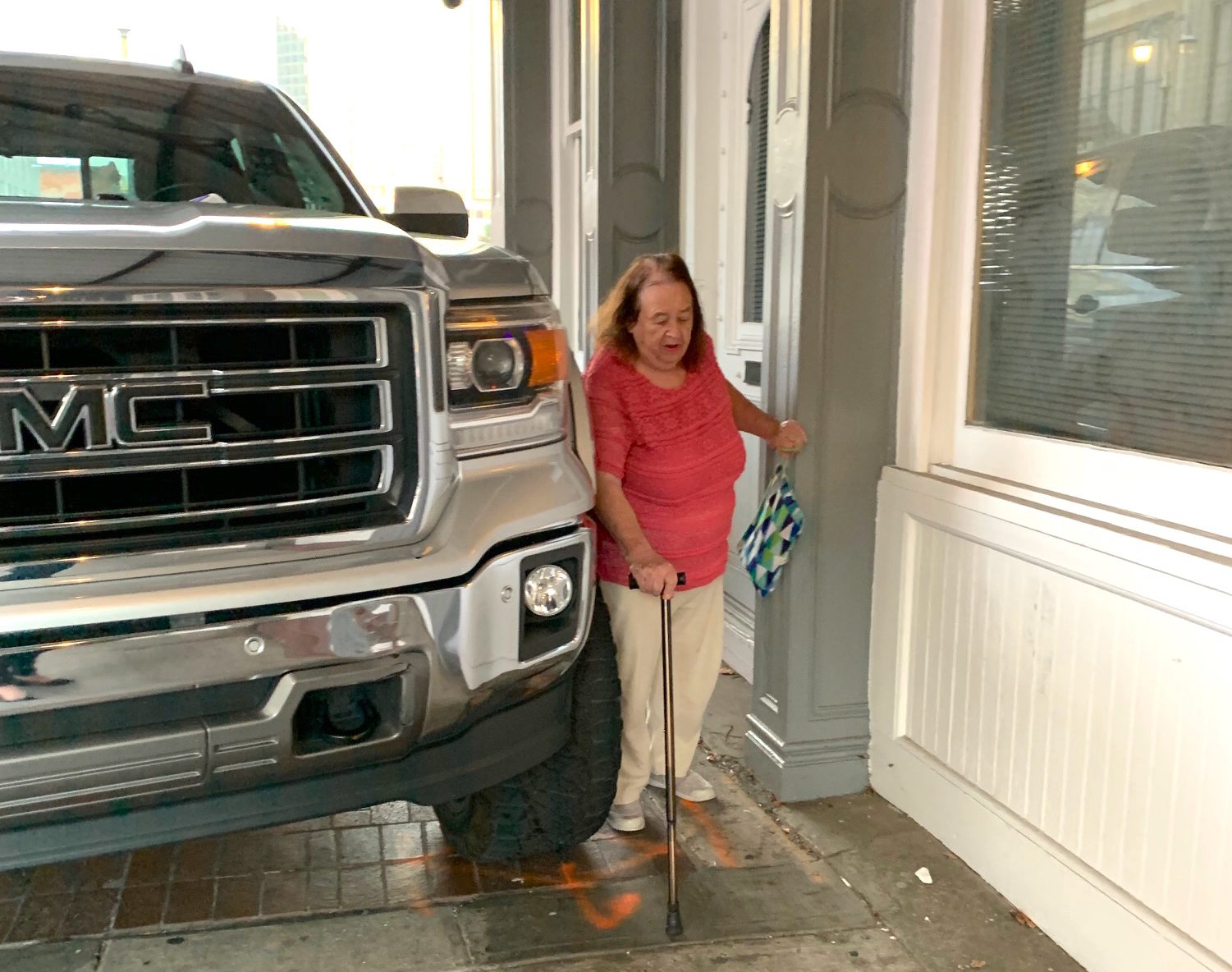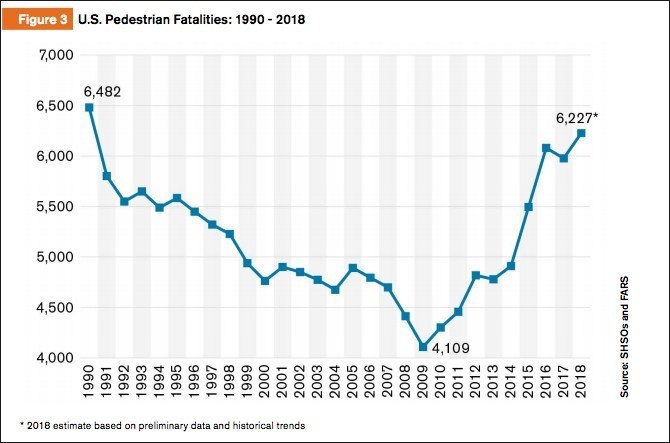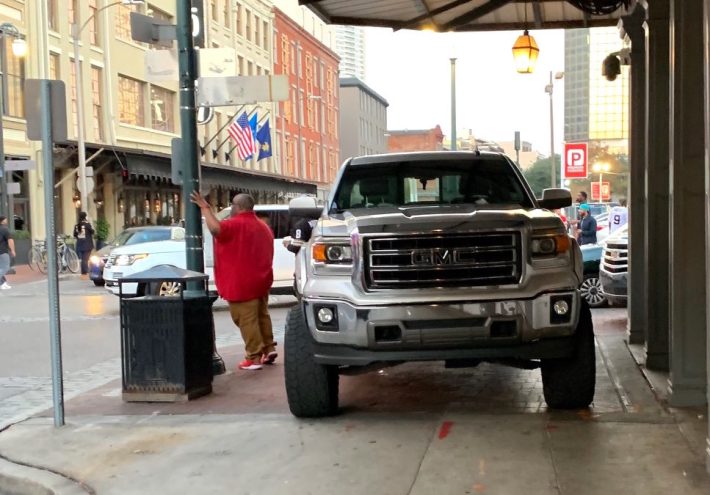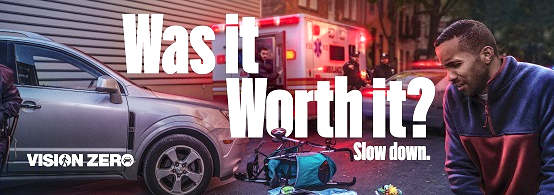Op-Ed: Wanted — a Strategy for Curtailing SUVs and Monster Trucks
12:03 AM EST on January 8, 2020

Whoa! A five-foot-two, cane using elderly woman, a cousin of the author, is no match for this monster GMC truck parked on a sidewalk in New Orleans. Photo: Martha Roskowski
City & State NY will be hosting a full day New York in Transit Summit on Jan. 30 at the Museum of Jewish Heritage. This summit will bring together experts across sectors to assess the current state of New York's transportation systems, break down recent legislative actions, and look towards the future of all things coming and going in New York. Join Keynote Speaker Polly Trottenberg, commissioner of the NYC Department of Transportation, along with agency leaders, elected officials, and advocates to assess the current state of New York’s transportation systems, and discuss the future. Use the code STREETSBLOG for a 25-percent discount when you RSVP here!
Sometimes a picture really is worth a thousand words. And so it was recently when I snapped a photo of my elderly cousin as she tried to maneuver around a pick-up truck parked on a New Orleans sidewalk. My cousin walks very slowly and uses a cane, so it took her several minutes to navigate around the truck.
At 5-feet-2, she couldn’t see into the driver's window or over the hood as she walked past — which means that a driver couldn’t see her either, if, say she was in a crosswalk! The high bumper and grill also indicate that a person hit by the truck would likely be plowed under it — rather than thrown up on the hood.
As my cousin winded past the truck, I pondered the new class of SUVs and pick-ups proliferating on our streets. The manufacturers call them “full-sized” when "oversized" might be a better word. These trucks are huge.
How are these legal? Not to mention that the dude parked it on the sidewalk. My elderly cousin has enough trouble walking... pic.twitter.com/oa0O4HjXrD
— Martha Roskowski (@martharoskowski) December 9, 2019
I tweeted a picture, asking, “How are these things legal?” The response was speedy and decisive: They should not be legal.
OK. But how does that happen? Safe-streets activists must devise a strategy for making that change.
We need a national strategy that combines local action to curtail the places drivers can take such vehicles with a concerted campaign to change their design by dramatizing the dangers. In this, we could take a page from Europe, which already regulates vehicle sizes and is moving to ban oversize vehicles from downtowns.
Cities could have an impact. They can regulate vehicles based on size and weight, and some are exploring the concepts of car-free downtowns and low-emission zones. Some have suggested that New York City could discourage SUV use by slapping higher tolls on heavier vehicles when congestion pricing is introduced in 2021.
New York, for its part, is trying persuasion — even shaming — in a bid to get SUV drivers to slow down. The city’s Department of Transportation recently launched an ad campaign highlighting the fact that about three-quarters of the drivers involved in fatal crashes in recent years were male, and that an increasing percentage of them were driving SUVs. Billboards beseeching men “Was It Worth It?” at least shift the focus from the rote victim-blaming of why people walking aren’t clad in neon vests. But can they counter the car-manufacturer ads touting the power and control of rolling down the road in an impregnable fortress? A piecemeal approach to discouraging large vehicles is unlikely to have a significant effect on the consumer market.

If Americans truly cared about the safety of pedestrians and cyclists, however, we would require the modification of the design of these trucks. Put simply, these vehicles are killing us. In 2018, pedestrian fatalities reached a 10-year high of 6,227 in the United States, up 51 percent from 10 years prior. In fact, the figure was the highest it had been since 1990. Children and the elderly are especially vulnerable in traffic crashes.
The growth in fatalities is entirely attributable to the size of the vehicles people buy — SUVs now comprise 65 percent of the market, and these light trucks are two-and-a-half to three times more likely to kill than a sedan. Sales of pick-up trucks like the one that dwarfed my cousin are soaring, too, so much so that they’ve been dubbed Detroit’s “golden geese.”
Of course, because of the high demand and profit margins on these vehicles, manufacturers have no incentive for ending the big-truck arms race. In fact, it's getting worse. Our laws and policy subsidize and incentivize driving. Barring some kind of oil shock that sends consumers fleeing from gas-guzzlers, don’t expect to dissuade buyers anytime soon. Even climate considerations don’t seem to sway people. From the start of the SUV boom 20 years ago, regulators ignored serious safety questions about the vehicles, such as their propensity for rollovers — all because of automakers were reaping such fantastic profits. Now, with President Trump seeking to relax fuel-economy standards, some American automakers have stopped making sedans in favor of oversized vehicles.
"Federal safety regulators have known for years that SUVs, with their higher front-end profile, are at least twice as likely as cars to kill the walkers, joggers and children they hit, yet have done little to reduce deaths or publicize the danger," an exasperated Detroit Free Press reported in a landmark 2018 expose, "Death on Foot," adding, "A federal proposal to factor pedestrians into vehicle safety ratings has stalled, with opposition from some automakers."

How to counter? The most direct and rational approach to curtailing oversized passenger vehicles would be to agitate for the United States to adopt a reasonable set of pedestrian-safety standards like those in Europe and Japan. The European Union has a strict set of requirements for vehicle design that increase the chances that someone will survive being hit by a vehicle. The rules include requirements about visibility and side guards, but also design standards that require that most the force of a collision be absorbed by the vehicle rather than the human body.
Such standards have prompted calls to ban Tesla’s new Cybertruck in Europe because of its stiff, stainless-steel construction, for example.

Which is not to say that there is no place for SUVs or trucks in American life — such as in rural areas or western states. And some working people need big vehicles to haul cargo, for example.
But even if there are legitimate uses for trucks and SUVs, that doesn’t mean they belong in Midtown Manhattan or that we must pay for ever-larger and more dangerous vehicles with the lives of people walking and biking.
The Vision Zero goal of zero traffic deaths is based on the idea the crashes are preventable if we redesign roads, manage speed and design safer vehicles. Today’s vehicles are safer for occupants because of seatbelt laws, airbags and other design features. The safety of those outside of cars has received far less attention.
Activists, industry and government can find common ground in standards that ensure that vehicle designs are safe for both occupants and people on the street.
Martha Roskowski (@martharoskowski) is a mobility advisor and long-time observer of the transportation world. She serves on the advisory committee for the Vision Zero Network.
Stay in touch
Sign up for our free newsletter
More from Streetsblog New York City
Thursday’s Headlines: Speed-Limiting Tech Edition
State Sen. Andrew Gounardes continues his push to force reckless drivers to install speed limiters in their cars. Plus more news.
DOT Official: All Our Free Parking Justifies Keeping Curb Space for EVs
If only someone could do something about the parking!
New York City to Install 500 Secure Bike Parking Hubs In The Next Five Years: Sources
Your bike may finally get a roof over its head.
Adams Backs Lower Speed Limits, Calls Crashes ‘Accidents’
The mayor wants New York City drivers to "slow down," but it's not clear yet how many streets will get lower speed limits.
Wednesday’s Headlines: Trump Posts About Congestion Pricing Edition
Donald Trump comments on congestion pricing — no surprise, he's against it. Plus more news.





